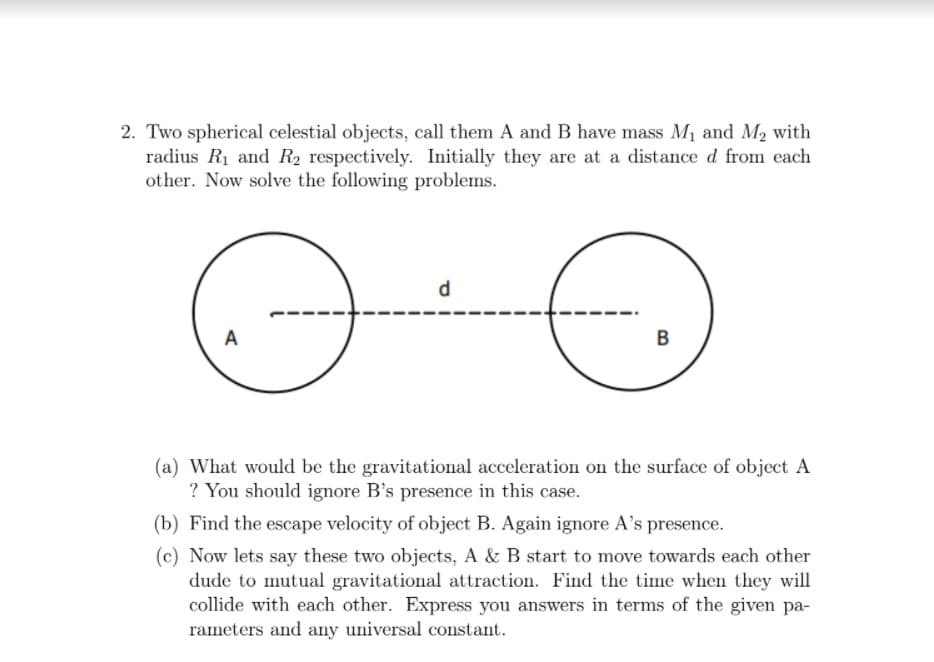2. Two spherical celestial objects, call them A and B have mass M1 and M, with radius R1 and R2 respectively. Initially they are at a distance d from each other. Now solve the following problems. A (a) What would be the gravitational acceleration on the surface of object A ? You should ignore B's presence in this case. (b) Find the escape velocity of object B. Again ignore A's presence. (c) Now lets say these two objects, A & B start to move towards each other dude to mutual gravitational attraction. Find the time when they will collide with each other. Express you answers in terms of the given pa- rameters and any universal constant.
2. Two spherical celestial objects, call them A and B have mass M1 and M, with radius R1 and R2 respectively. Initially they are at a distance d from each other. Now solve the following problems. A (a) What would be the gravitational acceleration on the surface of object A ? You should ignore B's presence in this case. (b) Find the escape velocity of object B. Again ignore A's presence. (c) Now lets say these two objects, A & B start to move towards each other dude to mutual gravitational attraction. Find the time when they will collide with each other. Express you answers in terms of the given pa- rameters and any universal constant.
Physics for Scientists and Engineers: Foundations and Connections
1st Edition
ISBN:9781133939146
Author:Katz, Debora M.
Publisher:Katz, Debora M.
Chapter6: Applications Of Newton’s Laws Of Motion
Section: Chapter Questions
Problem 57PQ: When a star dies, much of its mass may collapse into a single point known as a black hole. The...
Related questions
Question

Transcribed Image Text:2. Two spherical celestial objects, call them A and B have mass M1 and M, with
radius R1 and R2 respectively. Initially they are at a distance d from each
other. Now solve the following problems.
d
A
(a) What would be the gravitational acceleration on the surface of object A
? You should ignore B's presence in this case.
(b) Find the escape velocity of object B. Again ignore A's presence.
(c) Now lets say these two objects, A & B start to move towards each other
dude to mutual gravitational attraction. Find the time when they will
collide with each other. Express you answers in terms of the given pa-
rameters and any universal constant.
Expert Solution
This question has been solved!
Explore an expertly crafted, step-by-step solution for a thorough understanding of key concepts.
This is a popular solution!
Trending now
This is a popular solution!
Step by step
Solved in 3 steps with 3 images

Knowledge Booster
Learn more about
Need a deep-dive on the concept behind this application? Look no further. Learn more about this topic, physics and related others by exploring similar questions and additional content below.Recommended textbooks for you

Physics for Scientists and Engineers: Foundations…
Physics
ISBN:
9781133939146
Author:
Katz, Debora M.
Publisher:
Cengage Learning

Principles of Physics: A Calculus-Based Text
Physics
ISBN:
9781133104261
Author:
Raymond A. Serway, John W. Jewett
Publisher:
Cengage Learning

Physics for Scientists and Engineers, Technology …
Physics
ISBN:
9781305116399
Author:
Raymond A. Serway, John W. Jewett
Publisher:
Cengage Learning

Physics for Scientists and Engineers: Foundations…
Physics
ISBN:
9781133939146
Author:
Katz, Debora M.
Publisher:
Cengage Learning

Principles of Physics: A Calculus-Based Text
Physics
ISBN:
9781133104261
Author:
Raymond A. Serway, John W. Jewett
Publisher:
Cengage Learning

Physics for Scientists and Engineers, Technology …
Physics
ISBN:
9781305116399
Author:
Raymond A. Serway, John W. Jewett
Publisher:
Cengage Learning

Physics for Scientists and Engineers
Physics
ISBN:
9781337553278
Author:
Raymond A. Serway, John W. Jewett
Publisher:
Cengage Learning

Physics for Scientists and Engineers with Modern …
Physics
ISBN:
9781337553292
Author:
Raymond A. Serway, John W. Jewett
Publisher:
Cengage Learning

University Physics Volume 1
Physics
ISBN:
9781938168277
Author:
William Moebs, Samuel J. Ling, Jeff Sanny
Publisher:
OpenStax - Rice University